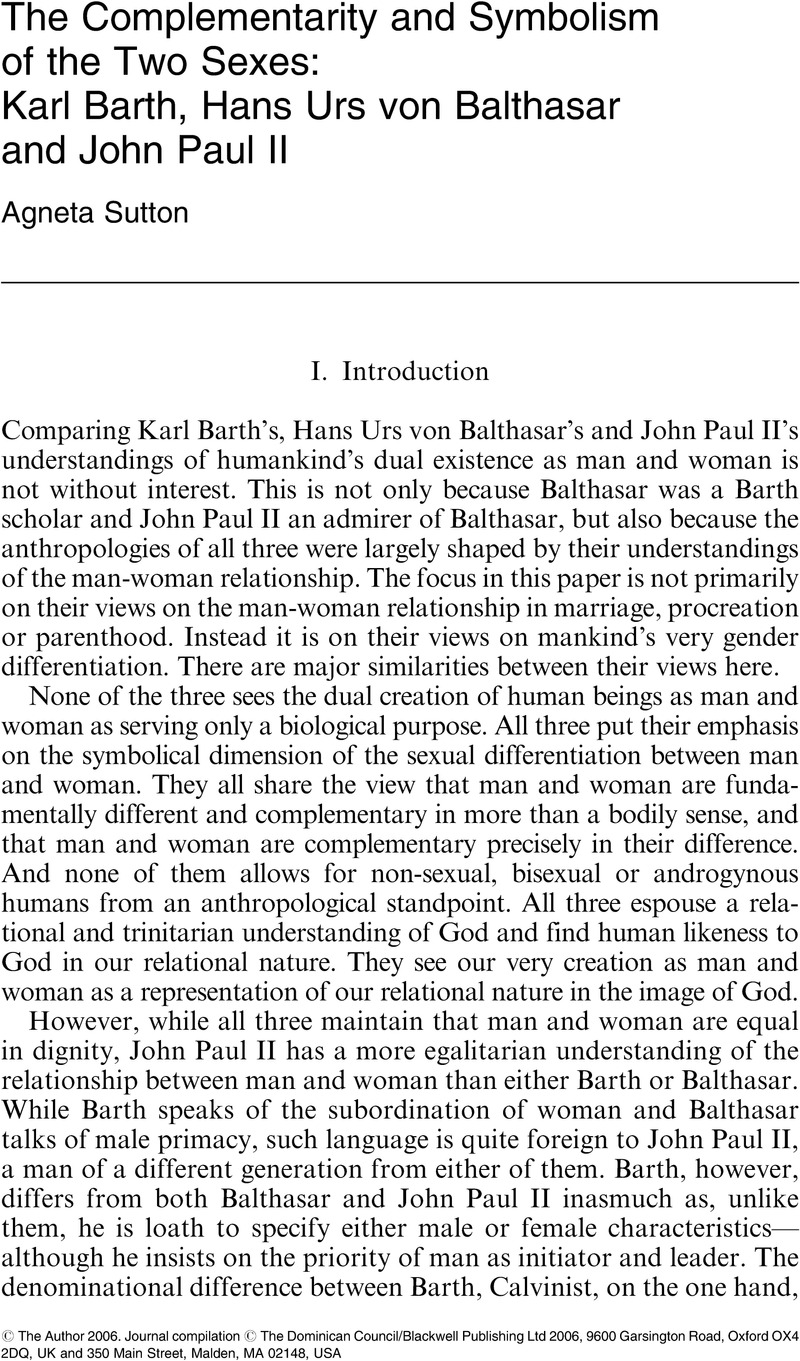No CrossRef data available.
Published online by Cambridge University Press: 01 January 2024

1 Barth, Karl, Church Dogmatics III, 4, ed., Bromiley, G W and Torrance, T F (Edinburgh: T&T Clark, 1961), p. 117Google Scholar. Henceforth abbreviated as CD III.4.
2 Ibid.
3 Barth, CD III.4, p. 153.
4 Barth, a Calvinist, does, of course, not accept the Roman Catholic and Orthodox views of marriage as a sacrament or sign on a par with baptism and mediating grace. For Barth, marriage is ‘simply and genuinely creaturely’. See, CD III.4, pp. 124–125.
5 Balthasar, Hans Urs von, Theo-Drama: Theological Dramatic Theory II: Dramatis Personae: Man in God(San Francisco: Ignatius Press, 1976), p. 365Google Scholar. Henceforth abbreviated as TD II.
6 Balthasar, TD II, pp. 381–382.
7 Balthasar, Hans Urs von, Love Alone is Credible(San Francisco: Ignatius Press, 1963), p. 77Google Scholar.
8 John Paul II, Apostolic Letter, Mulieris Dignitatem(Dublin: Veritas Publications, 1988), p. 22Google Scholar. Henceforth abbreviated as MD.
9 John Paul II, MD, pp. 22–23.
10 Paul, John II, The Theology of the Body: Human Love in the Divine Plan(Boston: Pauline Books and Media, 1997), p. 312Google Scholar. Henceforth abbreviated as ToB.
11 This understanding of human relationships indicates an understanding of God not unlike that of Colin Gunton or John Zizioulas. Gunton writes: ‘… it is this point—that the being of God lies in the relation of persons—that is so important for us. The contemporary Greek theologian, John Zizioulas, has elaborated something of its meaning: “In God the particular is ontologically ultimate … In trying to identify a particular thing we have to make it part of a relationship, and not isolate it as an individual’. See Gunton, Colin E, The Promise of Trinitarian Theology(Edinburgh: T&T Clark, 1997), pp. 95–96CrossRefGoogle Scholar.
12 Barth, CD III,4, p. 117
13 Barth, CD III.4, p. 120.
14 Barth, CD III.4, p. 149.
15 Barth, CD III.4, p. 163.
16 Barth, CD III.4, p. 163.
17 Barth, CD III.4, p. 163.
18 Barth, CD III.4, p. 153.
19 Barth, CD III.4, p. 154.
20 Balthasar, TD II, p. 365.
21 Balthasar, TD II, p. 365.
22 Balthasar, TD II, pp. 365–366.
23 Balthasar, TD II, p. 370.
24 Balthasar, Love Alone is Credible, pp. 77–78.
25 Beattie, Tina, ‘A Man and Three Women. Hans, Adrienne, Mary and Luce’, New Blackfriars Vol. 79, No. 927 (1998), pp. 97–105CrossRefGoogle Scholar.
26 Balthasar, TD II, p. 366.
27 Balthasar, TD II, p. 365.
28 John Paul II, ToB, p. 58.
29 John Paul II, ToB, p. 45.
30 John Paul II, ToB, p. 46.
31 John Paul II, ToB, p. 61.
32 John Paul II, ToB, p. 63.
33 John Paul II, ToB, p. 58.
34 John Paul II, MD, p. 24.
35 Barth, CD III.4, p. 166.
36 Ibid.
37 Barth, CD III.4, p. 168.
38 Barth, CD III.4, p. 169.
39 Barth, CD III.4, p. 164.
40 Barth, CD III.4, p. 169.
41 Barth, CD III.4, p. 170.
42 Barth, CD III.4, p. 172.
43 Barth, CD III.4, p. 175.
44 Barth, CD III.4, p. 169.
45 Barth, CD III.4, p. 175.
46 Barth, CD III.4, p. 176.
47 Barth, CD III.4, p. 177.
48 Barth, CD III.4, p. 181.
49 Balthasar, TD II, p. 373. As noted above, however, there are other times when he speaks of their mutual fulfillment.
50 Balthasar, TD II, p. 373.
51 Ibid.
52 Balthasar, TD II, p. 381.
53 Balthasar, TD II, p. 413.
54 Balthasar, TD II, p. 414.
55 Balthasar may here have had in mind his own (sexless) relationship with Adrienne von Speyr, whom he regarded as his alter ego.
56 John Paul II, ToB, p. 315.
57 John Paul II, ToB, pp. 309–311.
58 John Paul II, ToB, p, 310.
59 John Paul II, ToB, pp. 304–344; MD, pp. 9–103.
60 John Paul II, ToB, p. 310.
61 John Paul II, ToB, p. 94.
62 John Paul II, Encyclical Letter, Redemptoris Mater(Sherbrook, Quebec: Editions Paulines, 1987), p. 24. Henceforth abbreviated as RM.Google Scholar
63 John Paul II, RM, p. 26.
64 John Paul II, MD, p. 95.
65 John Paul II, ToB, p. 320.
66 John Paul II, MD, p. 106.
67 John Paul II, ToB, p. 371.
68 Ibid.
69 Ibid.
70 Barth, CD III.4, p. 130.
71 Barth, CD III.4, p. 132.
72 Barth, CD III.4, p. 133.
73 Barth, CD III.4, p. 135.
74 Ibid.
75 Ibid.
76 Barth, CD III.4, p. 137.
77 Ibid.
78 Barth, CD III.4, p. 149.
79 Barth, CD III.4, p. 158.
80 Barth, CD III.4, p. 155.
81 Barth, CD III.4, p. 154.
82 Barth, CD III.4, p. 156.
83 Balthasar, Love Alone is Credible, p. 77.
84 John Paul II, MD, p. 36.
85 John Paul II, MD, p. 37.
86 Ibid.
87 John Paul II, MD, p. 29.
88 John Paul II, MD, p. 59,
89 John Paul II often speaks of Mary's spiritual motherhood as a model for women—as well as for the Church. See for example, Redemptoris Mater, pp. 77–81.
90 John Paul II, MD, p. 112.